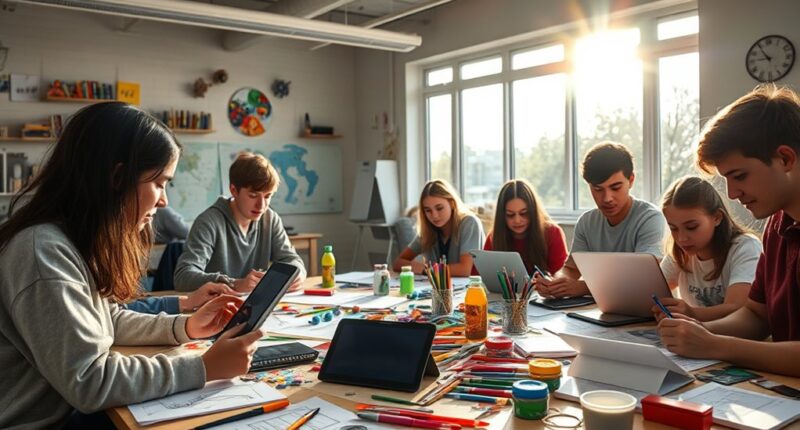To cultivate creativity through project-based learning, focus on engaging students in real-world problems that spark curiosity and encourage exploration. Use collaborative projects that allow students to take ownership of their learning and develop critical thinking, problem-solving, and innovation skills. Incorporate authentic scenarios and flexible assessments that highlight growth and effort. Creating a supportive environment helps students express ideas freely and experiment with new approaches. Keep exploring, and you’ll discover even more ways to foster creative, active learners.
Key Takeaways
- Incorporate real-world problems to stimulate curiosity and innovative thinking in projects.
- Use collaborative, interdisciplinary tasks to encourage diverse perspectives and creative solutions.
- Provide opportunities for students to experiment, iterate, and refine their ideas through hands-on activities.
- Integrate digital tools and multimedia to enhance expression and foster technological creativity.
- Offer flexible, formative assessments that emphasize process, reflection, and growth to inspire imaginative approaches.

Project-Based Learning (PBL) is an instructional approach that engages students in exploring real-world problems through sustained, hands-on projects. When you adopt PBL, you tap into students’ natural curiosity, encouraging them to take ownership of their learning. This method fosters student engagement by making lessons relevant and meaningful, which motivates students to invest effort and persist through challenges. Instead of passive listening, students become active participants, collaborating, researching, and applying knowledge to authentic scenarios. As a result, they develop critical thinking skills and a deeper understanding of content.
To maximize student engagement, your assessment strategies need to be flexible and formative. Traditional tests might not fully capture what students learn through project work. Instead, you should incorporate ongoing assessments such as rubrics, peer evaluations, and self-reflections. These tools allow you to gauge students’ progress continuously, providing timely feedback that guides improvements while recognizing their efforts. This approach helps students see their growth over time, boosting their confidence and motivation. It also encourages a growth mindset, as students learn to value the learning process rather than just final grades.
Designing assessments that align with project goals is essential. For example, if students are working on a community service project, you might assess their research process, teamwork, creativity, and presentation skills. These assessments should be transparent and criteria-based, so students understand expectations clearly. Incorporate opportunities for self-assessment, where learners evaluate their own contributions and learning. This promotes reflection and helps students develop metacognitive skills, which are indispensable for lifelong learning. Additionally, understanding the importance of attention to detail can help students produce higher quality work and reduce errors in their projects.
Another effective strategy involves peer assessment, where students critique each other’s work constructively. This not only enhances engagement by fostering a sense of accountability but also encourages collaborative learning. When students see their peers’ perspectives and feedback, they gain new insights and develop communication skills. Additionally, you can integrate digital tools that facilitate ongoing assessment, such as online portfolios or project management platforms. These tools help students document their progress and reflect on their learning journey.
Ultimately, your goal is to create a supportive environment where assessment becomes a tool for growth rather than just a measure of achievement. By combining varied assessment strategies with engaging, real-world projects, you cultivate creativity and help students develop the skills necessary to navigate complex problems confidently. When students feel their efforts are valued and their progress recognized, their enthusiasm for learning and willingness to take risks increase. This cycle of engagement and assessment drives a deeper, more meaningful learning experience, making PBL a powerful approach to cultivating creativity.
Frequently Asked Questions
How Can PBL Be Adapted for Different Age Groups?
You can adapt PBL for different age groups by using age-appropriate strategies and considering developmental considerations. For younger students, simplify tasks, incorporate play, and focus on basic skills. For older students, introduce more complex projects, foster independence, and encourage critical thinking. Adjust the complexity, resources, and collaboration levels to match their cognitive and social development, ensuring each group stays engaged and benefits from the project-based approach.
What Are Common Challenges Faced When Implementing PBL?
You might find that implementing PBL challenges student motivation, especially if projects seem disconnected from their interests. Classroom management can also become tricky, as students work independently or in groups. Balancing guidance with autonomy often requires effort, and some students may struggle with deadlines or staying engaged. These common hurdles demand patience and strong facilitation skills to guarantee the project fosters creativity and keeps everyone motivated.
How Is Student Assessment Managed in PBL Environments?
In PBL environments, you manage student assessment through a mix of formative assessments and peer evaluations. You regularly check understanding with informal activities, providing timely feedback to guide progress. Peer evaluation encourages students to reflect on their work and learn from each other. This ongoing assessment approach helps you adjust instruction, captures authentic skills, and promotes deeper learning, ensuring students stay engaged and accountable throughout their projects.
What Resources Are Essential for Successful PBL?
You need essential resources like clear project planning tools and effective resource management strategies to succeed in PBL. Start by outlining your project goals and timelines, ensuring you have access to materials, technology, and expert support. Managing resources efficiently keeps the project on track and minimizes disruptions. These resources help you stay organized, foster collaboration, and ultimately create a productive environment that encourages creativity and active learning.
How Does PBL Support Diverse Learning Styles?
You might think PBL only suits certain learners, but it actually supports diverse styles through multisensory engagement and personalized learning. By involving hands-on activities, visuals, and discussions, it appeals to visual, auditory, and kinesthetic learners. Personalizing projects allows you to tailor tasks to individual strengths and interests, making learning more meaningful. This inclusive approach helps every student thrive, fostering confidence and deeper understanding across all learning preferences.
Conclusion
By embracing project-based learning, you plant seeds of curiosity and innovation that grow into a vibrant forest of creativity. As you guide students through real-world challenges, you open their potential to think critically and collaborate effectively. Remember, this approach is the compass that steers learners toward discovery, turning education into a journey rather than a destination. With each project, you cultivate a garden where ideas flourish and future innovators bloom.










